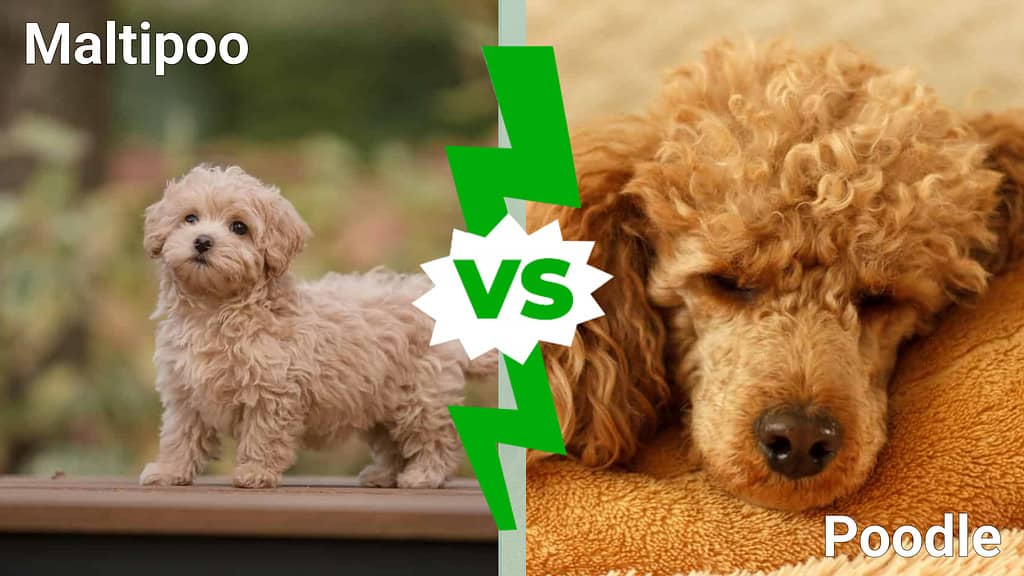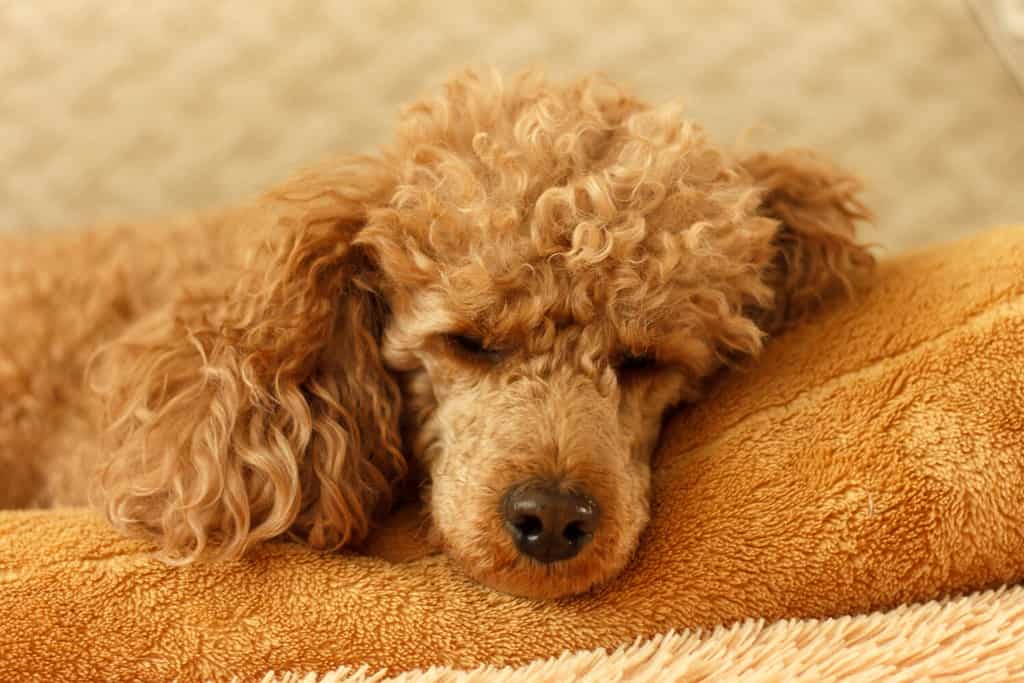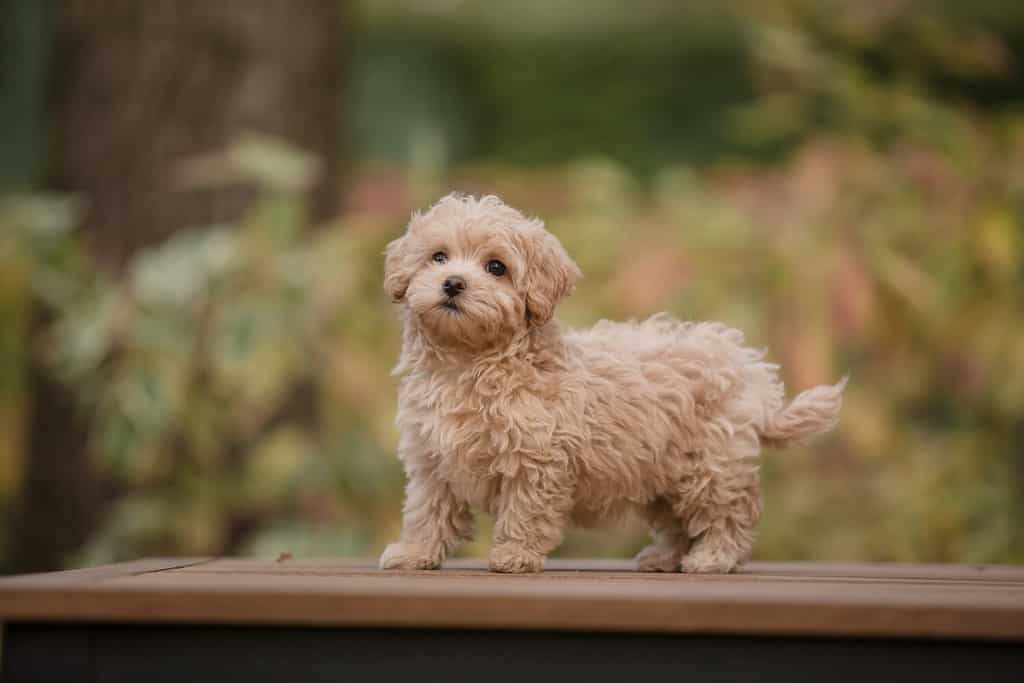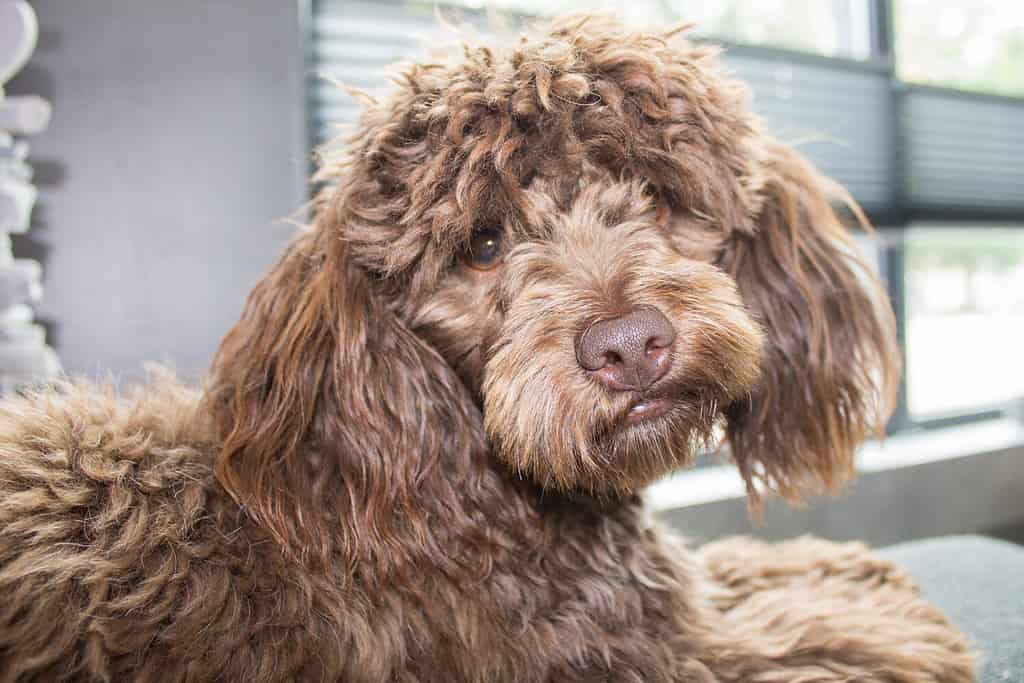A Maltipoo is a mixed breed dog, bred from a Maltese and either a toy or miniature Poodle. The Poodle breeds are very similar in temperament and appearance, but Toy Poodles are smaller. When it comes to the difference between Maltipoos vs. Poodles, there are many!
Maltipoos tend to be smaller, though not always. They may be more protective or stubborn due to their Maltese ancestry. And they may have more health problems, depending on breeding.
In this article, we’ll discuss eight key differences between Maltipoos and Poodles, some of their similarities, and what to expect from these dogs. Keep in mind that every dog is an individual, and the information here applies broadly to most dogs of these breeds–not all!
Maltipoo vs. Poodle: A Comparison

| Key Differences | Maltipoo | Toy Poodle | Miniature Poodle |
| Height | 7-15 inches | <10 inches | 10-15 inches |
| Weight | <15 pounds | 4-6 pounds | 10-15 pounds |
| Coat | Long, curly coat | Long, curly coat | Long, curly coat |
| Temperament | Protective, stubborn, affectionate | Friendly, playful, intelligent, vocal | Friendly, playful, intelligent, vocal |
| Exercise Needs | Moderate to high | High | High |
| Trainability | Easy to moderate | Easy | Easy |
| Life Expectancy | 10-18 years | 10-18 years | 10-18 years |
| Health Problems | May have more health issues due to poor breeding | Likely to have less health issues if purchased from a reputable breeder | Likely to have fewer health issues if purchased from a reputable breeder |
| Ethically bred? | Almost never | Sometimes | Sometimes |
| Purebred? | No | Yes | Yes |
Key Differences Between Maltipoos and Poodles
The eight key differences between Maltipoos vs. Poodles are their height, weight, temperament, exercise needs, trainability, life expectancy, health problems, and purebred status.
Toy Poodles tend to be a bit smaller than Maltipoos, while miniature Poodles are a bit larger. Both Poodle breeds tend to be more biddable, vocal, and friendly toward strangers, while Maltipoos may be more protective of their humans or homes.
Maltipoos may live shorter lifespans than Poodles and don’t tend to be ethically bred. It’s always important to research your breeder thoroughly if going that route or to adopt from a reputable rescue or shelter.
Let’s delve further into Maltipoos vs. Poodles, plus what to expect from each!
Appearance

Maltipoos and Poodles have very similar coats.
©225887559/Shutterstock.com
Height
Maltipoos may stand anywhere from seven to 15 inches tall, depending on which size of Poodle they’re bred from and which parent breed they take after. As with any mixed-breed trait, it can be unpredictable–even puppies from the same litter may range widely in size.
Toy Poodles stand under 10 inches tall, while miniature Poodles are typically 10-15 inches tall. Maltese are seven to nine inches tall.
Weight
Toy Poodles weigh just four to six pounds, while miniatures weigh 10-15 pounds. Maltese weigh under seven pounds.
A Maltipoo can fall into any of these ranges but will likely weigh under 15 pounds.
Coat
Maltese coats are always white and sometimes have black points. A Maltipoo may have this coloring, or they may have any of the following Poodle coat colors:
- Apricot
- Black
- Blue
- Brown
- Cream
- Red
- Silver
- Silver beige
- White
- Cafe Au Lait
- Gray
- Black and Cream
- Black and gray
- Black and silver
- Black and white
- Blue and white
- Brown and apricot
- Brown and white
- Black and apricot
- Cream and white
- Black and brown
- Gray and white
- Red and apricot
- Red and white
- White and apricot
- White and silver
- Black and tan
Some Poodles (and therefore some Maltipoos) also have non-standard markings such as a black or white mask, white markings, or black points.
Characteristics

Maltipoos may be more wary of strangers and more protective than Poodles.
©OlgaOvcharenko/Shutterstock.com
Temperament
Maltipoos may make better watchdogs than Poodles, as Maltese can have fairly strong guarding instincts. Maltese tend to bark less often than Poodles, but it’s possible for your Maltipoo to inherit those vocal Poodle genes!
Poodles tend to be friendlier toward strangers than Maltese and also more playful. Your Maltipoo might inherit these same characteristics, or be more like their Maltese parent.
Both Maltipoos and Poodles are incredibly affectionate, often to the point of clinginess and sometimes to the point of separation anxiety. They don’t do well when left alone for long periods.
They tend to be confident, loyal dogs who love to make their people happy. They can also be quite sensitive to the emotions of those around them and may not fare well in households with a lot of turbulence.
Social Needs
Both Maltipoos and Poodles have low prey drives, which makes them ideal for multi-pet households. They’re likely to get along with cats and other dogs.
Always make introductions slowly, and be extra careful if introducing your Poodle or Maltese to a larger dog with a high prey drive.
These dogs can make good companions for kids, but only if the children are taught how to interact with dogs. They’re small and can be easily hurt by rough handling, and a dog who’s hurt may bite in self-defense.
Teach kids to stay out of a dog’s face and away from their food bowl. Teach them to respect your dog’s boundaries and step in yourself when necessary.
Train your pup to respect your child’s space as well, and teach both how to interact calmly and gently with one another. Never leave children and dogs together unsupervised.
A patient, older rescue dog is often better suited to homes with children than a puppy since puppies are excitable and will bite during the teething phase.
Lastly, neither Maltipoos nor Poodles will thrive in homes where their people are away most of the day. Ideally, you have a partner who works opposite shifts or a family where at least one person is home most of the day.
Exercise Needs

Poodles are sometimes more energetic than Maltipoos and may require more exercise.
©Lim Tiaw Leong/Shutterstock.com
When it comes to exercise, both sizes of Poodle and Maltipoos are fairly easy to tire out. When needed, they can get out their energy by running around inside or in a small backyard.
Daily walks are ideal, both for exercise and mental stimulation. Sniffing and exploring the world is important for dogs!
Poodles tend to be more energetic than Maltese, so Maltipoos range from needing only moderate activity to having high exercise needs.
Mental Enrichment
Poodles need a great deal of mental enrichment, while Maltese need moderate amounts–so your Maltipoo may fall on either end of this spectrum.
Great enrichment activities for Poodles and Maltipoos include:
- Swimming–Poodles were bred to be in the water!
- Sniff walks
- Nose work games, such as hide-and-seek with treats, humans, or toys
- Dog sports, such as agility
- Games of fetch
- Puzzle toys
Trainability
Poodles are easy-going and eager to please. They’re also very intelligent and pick up on new cues incredibly fast!
Meanwhile, Maltese are also smart, but they use their intelligence a bit differently. They can be stubborn and may look for ways to bend the rules.
A Maltipoo may take on either of these traits or fall somewhere in the middle.
Regardless, consistency and force-free training methods are essential. Never use aversive or punishment-based training methods, even when your dog misbehaves, as these methods promote fear and sometimes aggression.
Keep training sessions short, fun, and rewarding! End on a good note, such as when they’ve just made progress on a new trick, rather than waiting until one or both of you becomes frustrated.
Health Factors

Maltipoos may have more health problems than Poodles due to poor breeding.
©MrKawa/Shutterstock.com
Life Expectancy
Poodles have a life expectancy of 10-18 years, while Maltese have a life expectancy of 12-15 years. This means that Maltipoos can live anywhere from 10-18 years but may pass sooner to that 12-15 year mark due to their Maltese heritage.
However, it’s important to remember that these are averages and that every dog is unique. Some toy breeds live into their twenties, and others die in puppyhood.
The best way to ensure your dog lives a long, healthy life is to shop with a reputable breeder who completes all recommended health testing. Diet, exercise, daily care, and vet care also impact lifespan.
Purchasing pet insurance for your dog can help extend their life by ensuring that, should an emergency happen, vet bills will be taken care of.
Health Problems
Both Maltese and Poodles are fairly healthy breeds, but you’ll see more health problems in dogs from backyard breeders or puppy mills since they typically don’t screen for health problems. This is also why you’re more likely to see excessive health problems in Maltipoos than in Poodles.
Some health problems you may see in both Maltipoos and Poodles include:
- Luxating patella
- Hip dysplasia
- Eye problems
- Dental disease
- Epilepsy
- Cushing’s disease
- Diabetes
- Skin issues and allergies
Maltipoos are more prone to heart and liver problems as well as encephalitis, a neurological disease.
Breeding Ethics
There are many reputable breeders who breed miniature and toy poodles, but most Maltipoo breeders are unethical.
This is because, generally, breeders should have a good reason to mix breeds and take on the unpredictability and risk that comes with doing so. But the Maltipoo is seen as a “designer dog,” or mixed breed that is easy to sell for a high price tag.
You’re almost always going to see them coming from puppy mills or backyard breeders. You’re unlikely to find Maltipoo breeders who health test the parent dogs, have the parents and puppies vetted and groomed, and who ensure their puppies never end up in shelters through contracts and microchips. These are just a few things you’ll see in every reputable breeder.
If your breeder doesn’t do these things, or you notice other red flags, it’s better to turn away than to support unethical breeding.
Please also keep in mind that DNA testing and genetic health testing are not the same. Many backyard breeders will buy cheap dog DNA kits to seem reputable while foregoing the actual testing necessary to breed ethically. A reputable breeder will have health test results available with OFA. For Maltipoos, this means all recommended tests for both Maltese and Poodles.
Wrapping Up: Maltipoo vs. Poodle
The key difference between the Maltipoo and Poodle is that one is purebred, while the other isn’t. Maltipoos may be slightly less predictable in all ways than Poodles or even purebred Maltese dogs, and they’re also very likely to be poorly bred, which can also impact their health.
Maltipoos are more likely to be protective and stubborn, while Poodles are less likely to be reserved around strangers and need more physical and mental enrichment.
Thank you for reading! If you have feedback on this post, please contact the AZ Animals editorial team.
The photo featured at the top of this post is ©
Ready to discover the top 10 cutest dog breeds in the entire world?
How about the fastest dogs, the largest dogs and those that are -- quite frankly -- just the kindest dogs on the planet? Each day, AZ Animals sends out lists just like this to our thousands of email subscribers. And the best part? It's FREE. Join today by entering your email below.
Thank you for reading! Have some feedback for us? Contact the AZ Animals editorial team.







